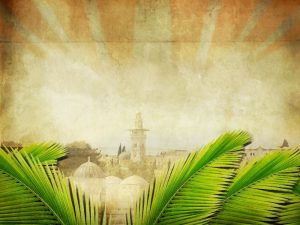
Matthew 21:1-17
Have you ever been to an event or meeting and something happened that you didn’t expect or fully understand?
The Sunday prior to Easter is Palm Sunday, the day when we traditionally remember Jesus coming into Jerusalem one week prior to his crucifixion and resurrection.
Everything that Jesus did on that day made a statement, he was intentionally dropping hints along the way about his identity and intentions. Those witnessing the events, did not see the significance of what Jesus was doing. Jesus was following a script that had been written before the creation of the world (see John 5:19).
Jesus avoided the limelight, throughout his public ministry. Most of Jesus’ ministry happened outside of towns or in small towns, away from the center of Jerusalem. But on Palm Sunday, all of that changed. In Matthews Gospel account we see six signs that Jesus left indicating his identity and purpose.The first sign we see is that Jesus instructs his disciples to go and get a donkey and her young foal and bring them to him.
His disciples dutifully obeyed and went and got him this wild animal that had never been ridden before. Riding into the city was a public declaration that Jesus was a king (See Zechariah 9:9). In times of war a conquering king would ride on a chariot or a stallion, but Jesus rode on a colt to declare that he is a king proclaiming peace.
But aside from the obvious declaration, this animal had never been ridden before. Anyone who has worked with horses before would know that you cannot simply ride a wild foal, it needs to be broken in, unless the creator of the foal was the one riding. The people didn’t recognize the creator God, but the foal did, the animal knew who was riding on its back, and it submitted to the authority of Jesus.
The people reacted by spreading their cloaks in front of Jesus, this was a sign of honor for a king as we see in 2 Kings chapter 9. The fact that the people were waving palm branches showed that they didn’t grasp who Jesus was, and why he was coming to Jerusalem. Two generations before this time, the Maccabean revolt took place that liberated the Israelites from the Syrian oppressors, at that time the worship in the temple was re-established. By waving palm branches, the people were expecting a military ruler to free them from the oppression of Rome, they expected Jesus to be another warlord or general of the armies, one who would lead them to liberation from their oppressors. They were ready to pick up their swords and go to war if Jesus would lead them!
In verse 9 we see that the people were crying out, “Hosanna to the Son of David! Blessed is he who comes in the name of the Lord! Hosanna in the highest!”.
We sing the word, Hosanna, and assume it is simply a declaration of worship, but it is a cry for help, it is a cry for salvation. The Aramaic word, Hosanna, comes from the Hebrew and the same word we find in Psalm 118:25, “Save us, we pray, O Lord! O Lord, we pray, give us success!”
The crowds were full of expectation that Jesus was coming to save them, but it was originally a cry for help. The people were misguided in their expectations of Jesus as the military messiah, but their declaration of Hosanna, was a prophetic declaration of the salvation that Jesus was about to bring through his death and resurrection.
Jesus enters Jerusalem and the whole city was stirred up, little did they know what was about to take place. The greatest and the darkest day in all of history. Jesus goes to the temple and begins to turn over the tables of the money changers and the traders. Jesus then quotes the Prophet Isaiah and says, “It is written, ‘My house shall be called a house of prayer,’ but you make it a den of robbers.”
We easily miss the significance of what Jesus was doing, he was making a public statement that the sacrificial system was not needed anymore, he was about to become the perfect and final sacrifice for all who would put their faith in him. Jesus was passing judgment on the sacrificial system. Even today we still need to be reminded that there is only one sacrifice that gains us favor with God, and it has already been completed when Jesus died and rose again.
In verse 14 we read, “And the blind and the lame came to him in the temple, and he healed them.” During the chaos and confusion, Jesus takes time to heal the blind and the lame.
Jesus was intentionally making a declaration of his true identity. The irony is that the seeing people were the blind ones. The blind came to him, because they recognized him for who he was.
Remember at the beginning of Jesus’ ministry, he went to the synagogue in Nazareth and read from Isaiah chapter 61 (see Luke 4:18-19). Jesus was declaring who he was, but the seeing were blind.
And then finally in verse 15, we read that the chief priests and scribes were indignant, they were offended because of the miracles, they were offended because the children were upsetting their neat little world of religion and crying out, “Hosanna to the Son of David!”
The priests were very religious, but religion – a set of rules and regulations to earn salvation – that is not for children. Christianity is a true relationship with our heavenly father through Jesus Christ and children get that much easier than adults do. Jesus quotes King David from Psalm 8:2. There is power in the praise of children, but more than that, the children hear from God much clearer than we adults do. The children are the faith and prophetic voices for the church as we get so busy “doing church”. We get so busy doing religion, that we miss the power of the praises and prayers of the children.
Jesus made statement after statement, declaring his true identity, but all the people in Jerusalem that day missed what he was saying.
Do you know who Jesus is?
Perhaps you follow Jesus because of his miracles and what you can get from him?
Do you follow Jesus because it is your tradition?
The only way of salvation is through recognizing who Jesus is and then submitting to him as Lord of your life.

